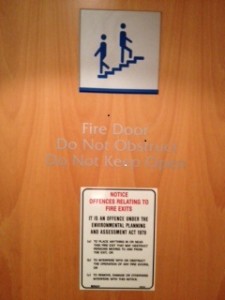 The woman in Room #837 is faking an orgasm.
The woman in Room #837 is faking an orgasm.
I know this because I’m five feet outside her door in this “luxury” Sydney hotel listening to her. (The only thing “luxury” about this place is the amount they charge to access the internet.)
If my phone had any sort of signal, I’d find the YouTube link to the famous scene from When Harry Met Sally and play it as loudly as possible so she’d know how it was done.
But alas, I don’t have any signal.
Nor do I have any energy.
It’s at least 110 degrees in here and I’m literally melting. (Think Wicked Witch scene at the end of Wizard of Oz but 100 times more dramatic.)
I pound on the door four more times and beg: “Please. Please. Open. This. Door.” Whimper. “Please…”
I think about offering to participate in a threesome if they’d just let me out of here but I’m not quite that desperate. I’m still deciding if death would be better than joining the awful sex they are having. Yes, I know. Sex is like Chinese food. Even if it’s bad, you still want it again anyway. But this sounds like food-poisoning-bad sex and I’ve already lost at least six pounds from this stifling heat.
More pounding. I feel – and look — like Fred Flintstone yelling at Wilma.
It’s 3:30 in the morning and I don’t particularly care who I wake up. I would pull the Fire Alarm if there was one. Hell, I’d start a fire if I could. Anything to get me out of this flipping place.
It’s hot. It’s dusty. It smells like mold. There are cigarettes strewn all over. I’m convinced I’d see human bones of the people who’ve gotten stuck in here before me if I actually looked. But I have neither the time nor the energy to dig for dead bodies, so I start kicking at the door with my feet instead of pounding it with my fists.
Nothing.
The only sounds of life are the grunts of the Neanderthal and the woman who thinks his name is God. Or Joe. She can’t seem to decide.
I glance down at the stairs and realize what an idiot I was to take the stairs. WHO TAKES THE STAIRS?
If I hadn’t taken the stairs, I wouldn’t be stuck.
Of course, when I hurriedly left my room and took the stairs I didn’t know that there was a difference between FIRE STAIRS and regular stairs and that ALL OF THE FIRE STAIRS WOULD BE LOCKED.
Every single level – every single exit – even the street level — locked tightly shut – just like something out of Sartre.
I didn’t know I’d be locked in the stairwell and I certainly didn’t realize I’d be stuck in Hell listening to God. Or Joe. Or whatever his damn name is.
I think about taking off my clothes. By the time anyone finds me, I’ll be all bones anyway…
If I was MacGyver I could do something with my shirt and the battery of my cellphone. Hmmm… If only I was MacGyver or my friend, James, who is even handier than MacGyver.
I glance down at my signal-less phone to check the time. (When I was more lucid, I calculated how long the sex would last – I even figured out a scenario if Caveboy had taken Viagra, one if he’d read the 15 minute orgasm chapter in Four Hour Body, and one if he’d done both.)
I’ve been trapped in here FOREVER.
FOREVER meaning exactly twenty one minutes.
People say time flies. And it does. Except when it doesn’t. When you’re a kid waiting for Santa or when you’re an adult trying to do something – anything — that needs to be done quickly — like escaping from a stairwell or getting in and out of a lead form or checkout as fast as possible. Then time is slower than death.
I did a seminar for Target Marketing Magazine last week and one of the things I got the most comments about afterwards is why I think user session is so important. Over a dozen people wrote and said “nobody else seems to think it’s important like you do – who is wrong? You or them?” (Them. Obviously.)
The time spent on your site has a huge influence on your success.
Why?
Because for every site there is a MAGIC amount.
There’s a time where you’re ok to be there – and then there’s that moment where everything immediately becomes not ok – and you feel like you’re trapped.
When I first walked out the fire stairwell door, everything was great. I bounced from my floor (#6) down to the floor where the gym was (#2.) I was looking forward to my workout (well, as much as one can look forward to a workout) and getting a jump on my morning.
Then I tried to open the door and it was locked. I was mildly irritated but I thought “no worries, I’ll just go to floor #1 and go up the ballroom stairs instead.”
Down to #1. Also locked. “It’s ok, they probably lock the street level doors so no vagrants come in.” (Bad logic since the street would be a better place than this God-er-Joe-forsaken hotel.)
Up to #3. “WTF? This is really irritating.”
Up to #4. “This is beyond irritating.”
Up to #5. “I’m going to sue someone.”
Up to #6 — the door I orginally exited from. “I’m going to kill someone.”
Up to #7. “I’m going to sue MANY PEOPLE and then I’m going to kill MANY MORE PEOPLE.“
Up to #8. The top floor of the hotel. “Oh my GodJoeGod, I AM GOING TO DIE IN THIS HOTEL and I still have two hours and $25 left of Internet! No wait. That’s not funny. I am REALLY GOING TO DIE HERE – alone – and nobody will find me for months – maybe years. And it’s going to be painful and I will go crazy and I will try to eat my own body parts to survive and nobody will even watch my movie on Lifetime and oh-my-Joe, PLEASE GET ME OUT OF HERE. PLLLLLLLLLLLEEEEEEEEEEEASSSSSEEEE.”
You can laugh – but the same thing happens when people struggle with your internal text search or get trapped in your lead form captchas and wackass checkouts.
We nicely warm and then all of a sudden – POOF! We boil!
Here’s the takeaway. (You didn’t think you were going to get sex tips did you?)
Active User Session – the length of time someone spends on your site. The general rule is the more they stay the more they pay. However, there is a right amount. So figure out how long it takes for your average transaction.
Active Average User Session – take your average user session and divide it by the number of drills. (If you can’t track drills, look at page views.) This will show you the average length of time the user spends per page on your site. You’ll know in an instant if people are looking at too many pages per minute or too few based on your conversion levels.
Knowing your user session (the length of time that someone spends on your site) and your average active user session (the length of time that someone stays on your site actively), can help you figure out exactly where your boiling point is. Once you know, you can figure out how to prevent it using triggered emails, pop-ups, instigated chat, and even telemarketing.
I’ll talk more about these metrics in a future post – but first things first, right now, if you haven’t already, you should just start tracking them. Ok? Ok.
P.S. In case you’re wondering, God (aka Joe) and his chiquita never opened the door for me. I forgive them because I’d be embarrassed about their bad sex too. The guy on Floor #7 – whom I woke up with all my “*&^%$#@ screaming” answered the door 33 minutes later. He was naked and let me tell you, I was way more traumatized from that particular incident than the sounds of bad sex. Thankfully for you, there are some things that even I can’t write about.








